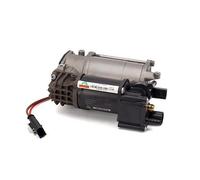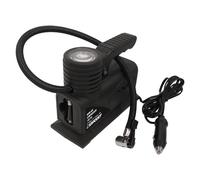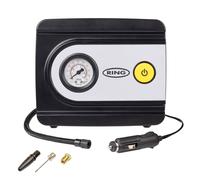Note: This text was created with the help of AI.








































- 1
- 2
- 3
- 4
- 5
- next page
Discover Amazing Offers on Compressors
Similar to an air pump, compressors alternate between sucking in and compressing gas. The piston sucks in the required air from the environment and compresses it in its housing, so that you can then release the air in a controlled manner.
Compression reduces the volume of the gas so that the pressure in the gas increases, enabling you to perform various tasks with compressed air.
Depending on the application, different compressors in different sizes and designs are useful.
If you use your compressor frequently and intensively, it should have an appropriately large pressure vessel to enable you to work with adequate pressure. These devices are particularly suitable for painting and sandblasting work as well as for operating pneumatic tools.
If you only use your compressor occasionally for filling tyres, rugby balls or similar purposes, you do not usually need a device with a compressed air tank. An air compressor with a low voltage is sufficient for this purpose.
You should pay particular attention to the manufacturer and its specifications.
For the drive of your compressor you should use special compressor oil, because the lubrication has a significant impact on the operation, performance and life of your device.
Compressor oil is a low-viscosity oil, which is less viscous than engine oil. This results in less friction than other oils. We therefore advise you not to use engine oil.
Compressor oil also has a cooling effect and reduces wear enormously. We recommend a viscosity of 100, for example compressor oil VDL 100. Find a fitting compressor oil in our category “Fuel & Oil Additives”.
With the help of the suction capacity you can calculate how long it takes until the tank is refilled. This way you know how often the compressor has to switch on while you are working.
From the intake capacity you can also derive the so-called output capacity. With your device, you should make sure that the intake power is 30 percent higher than the output power.
If you want your compressor to support you when sandblasting, the maximum pressure should be at least seven - preferably more - bars. A high pressure ensures that there is less friction between the individual sand particles and that you can distribute the sand more powerfully with the spray gun.
The necessary maximum pressure is usually achieved by most commercially available compressors.
The delivery rate should be at least 400 to 600 litres per minute. This value indicates how many litres of air the compressor can deliver per minute.
The boiler should hold at least 100 litres. The larger the boiler, the longer you can work without interruption.
A compressor for impact wrenches should have sufficient air capacity.
You need a device with sufficient operating pressure (approximately seven to ten bar) and sufficient air flow (200 to 400 litres per minute) to cover the compressed air requirements of the impact wrench. These values vary depending on the model.
Furthermore, you should pay attention to the size of the boiler, it applies:
- Compressor 50 liters: for private users (car / home worker).
- Compressor 100 litres: for hobby mechanics
- Compressor 200 litres: for professional workers
A compressor for your impact wrench should be oil-lubricated, as the fine oil film in the compressed air also lubricates your impact wrench and thus increases its service life.
If you are technically skilled, you can dismantle the cylinder head yourself with a few simple steps and fit a new seal to restore functionality.
Furthermore, the center web of the cylinder head gasket, which is located between the intake and exhaust valves, may have a defect.
Notice: When it comes to compressed air, you should take certain safety precautions.
Discover Amazing Offers on Compressors
Looking for the right compressor can be a game-changer for your projects, whether you're inflating tires, powering tools, or tackling DIY tasks. Pricehunter.co.uk presents a wide variety of compressors for sale, allowing you to compare prices and find exactly what you need, all in one place. Let’s explore the essential aspects of compressors that can help you make an informed decision.Types of Compressors
When considering a compressor, it's essential to understand the different types available. Each type caters to specific needs and environments.- Mobile Electric Air Compressor - Ideal for portability and convenience.
- Compressors can be categorized into **portable** and **stationary** versions, serving different purposes.
- **Piston compressors** are common for heavy-duty tasks, while **diaphragm compressors** are quieter and suitable for smaller jobs.
- Consider **oil-lubricated** vs. **oil-free** models, as each has its advantages and maintenance needs.
Top Brands for Compressors
Selecting a reputable brand can significantly influence the quality and durability of your compressor. Here are some notable brands known for their performance.- Dewalt Air Compressor 18V - Renowned for reliability and innovative technology.
- **Makita** is popular for its robust construction and professional-level tools.
- **Bostitch** compressors are often favored for their efficiency and lightweight design.
- **Black & Decker** provides a range of household and hobbyist compressors.
Useful Accessories for Compressors
Enhance the functionality of your compressor with the right accessories. These additions can make your tasks more efficient and enjoyable.- Pressure Switch for Air Compressor - Essential for regulating air pressure levels.
- **Air hoses** can improve mobility and reach during use.
- **Inflation kits** are handy for quickly filling tires and sporting equipment.
- **Filters and lubricants** will help maintain your compressor’s performance and longevity.
Smart Technology in Compressors
With advancements in technology, many compressors now feature smart capabilities that enhance usability and efficiency.- Electric Tyre Inflators - Some models include automatic shut-off features and digital pressure gauges.
- **Bluetooth connectivity** allows for easy monitoring and control via mobile apps.
- **Smart sensors** can alert users to maintenance needs or performance issues.
- **Energy-efficient models** help reduce power consumption without compromising on performance.
Usage Scenarios for Compressors
Understanding how and where you plan to use your compressor can help narrow down your choices significantly.- Car Inflator Compressor - Perfect for road trips and emergencies.
- **Home improvement projects** often require compressors for painting or powering pneumatic tools.
- **Construction sites** benefit from larger, industrial-grade compressors for heavy machinery.
- **Gardening and landscaping** can be enhanced with compressors used for powering tools like leaf blowers.
Note: This text was created with the help of AI.